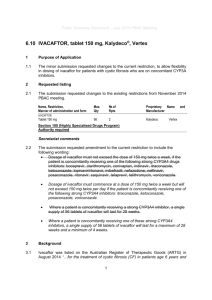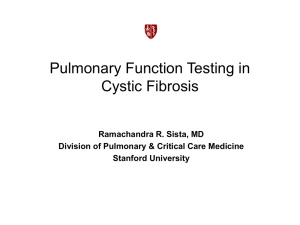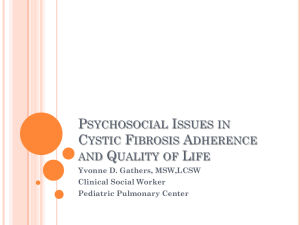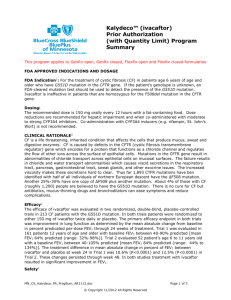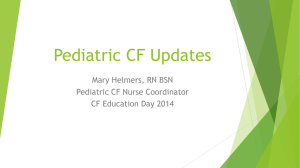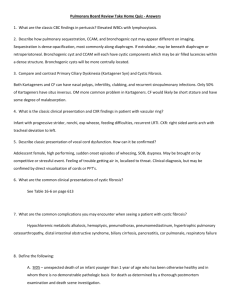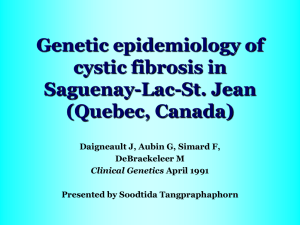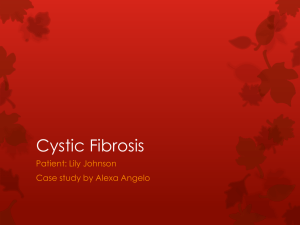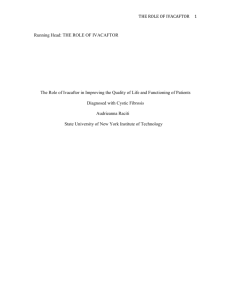Ivacaftor stakeholder meeting outcome statement - (Word 43 KB)
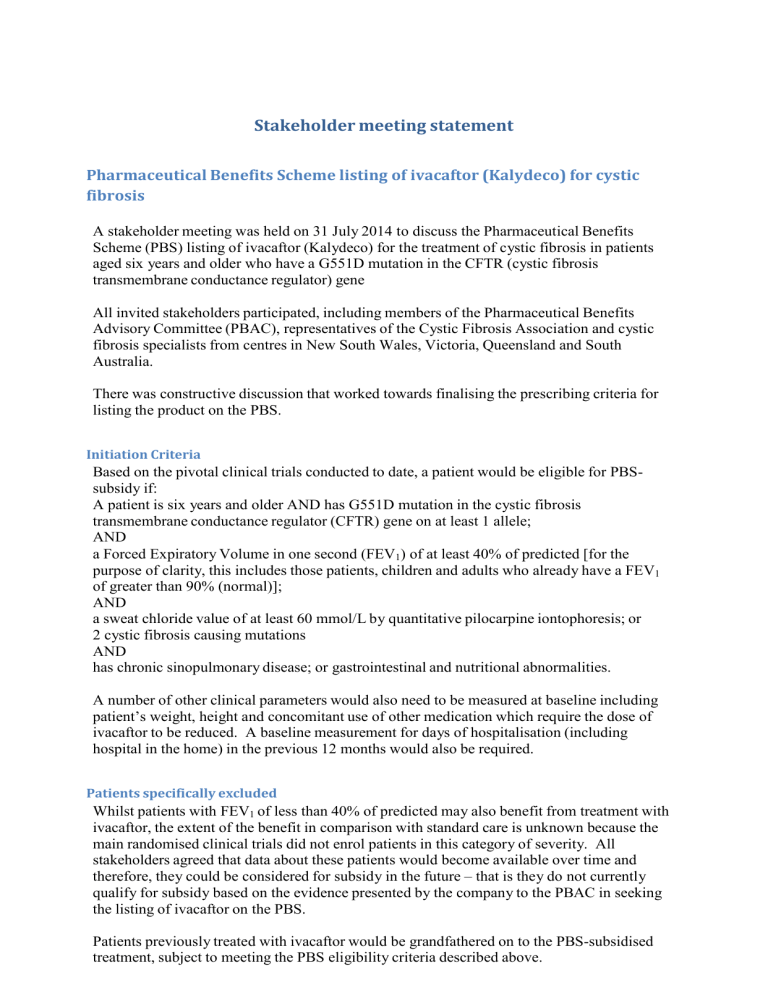
Stakeholder meeting statement
Pharmaceutical Benefits Scheme listing of ivacaftor (Kalydeco) for cystic fibrosis
A stakeholder meeting was held on 31 July 2014 to discuss the Pharmaceutical Benefits
Scheme (PBS) listing of ivacaftor (Kalydeco) for the treatment of cystic fibrosis in patients aged six years and older who have a G551D mutation in the CFTR (cystic fibrosis transmembrane conductance regulator) gene
All invited stakeholders participated, including members of the Pharmaceutical Benefits
Advisory Committee (PBAC), representatives of the Cystic Fibrosis Association and cystic fibrosis specialists from centres in New South Wales, Victoria, Queensland and South
Australia.
There was constructive discussion that worked towards finalising the prescribing criteria for listing the product on the PBS.
Initiation Criteria
Based on the pivotal clinical trials conducted to date, a patient would be eligible for PBS- subsidy if:
A patient is six years and older AND has G551D mutation in the cystic fibrosis transmembrane conductance regulator (CFTR) gene on at least 1 allele;
AND a Forced Expiratory Volume in one second (FEV
1
) of at least 40% of predicted [for the purpose of clarity, this includes those patients, children and adults who already have a FEV
1 of greater than 90% (normal)];
AND a sweat chloride value of at least 60 mmol/L by quantitative pilocarpine iontophoresis; or
2 cystic fibrosis causing mutations
AND has chronic sinopulmonary disease; or gastrointestinal and nutritional abnormalities.
A number of other clinical parameters would also need to be measured at baseline including patient’s weight, height and concomitant use of other medication which require the dose of ivacaftor to be reduced. A baseline measurement for days of hospitalisation (including hospital in the home) in the previous 12 months would also be required.
Patients specifically excluded
Whilst patients with FEV
1 of less than 40% of predicted may also benefit from treatment with ivacaftor, the extent of the benefit in comparison with standard care is unknown because the main randomised clinical trials did not enrol patients in this category of severity. All stakeholders agreed that data about these patients would become available over time and therefore, they could be considered for subsidy in the future – that is they do not currently qualify for subsidy based on the evidence presented by the company to the PBAC in seeking the listing of ivacaftor on the PBS.
Patients previously treated with ivacaftor would be grandfathered on to the PBS-subsidised treatment, subject to meeting the PBS eligibility criteria described above.
Continuation criteria
The PBS continuation criteria were also discussed, with treatment response assessments undertaken every six months.
Under the PBAC’s pay for performance recommendation of March 2014, all eligible patients could be treated with PBS-subsidised ivacaftor but the price paid by the Government varies depending on the magnitude of the benefit gained by patients, in recognition that not all patients respond equally to treatment.
The key criteria for assessing a benefit from treatment would be a combination of FEV
1
, weight gain and reductions in hospitalisations.
Adults
An optimal response following the first six-months of treatment would be an improvement of :
FEV
1 of at least 10% or more
AND
weight gain of at least 2.7kg or more
This initial clinical response must then be sustained over time (i.e. demonstrated at every six month assessment period thereafter to maintain access to the PBS-Subsidy) with an additional continuation criteria introduced after the first 12-months of treatment to reflect the balance of optimal clinical outcomes expected from treatment with this drug:
Maintenance of the FEV
1 gain of at least 10% or more demonstrated at 6 months AND
Maintenance of weight gain of at least 2.7kg or more demonstrated at 6 months AND
Halving of days of hospitalisation, including hospital in the home over a 12 month period in comparison with the preceding 12-months.
Children
An optimal response following the first six-months of treatment would be an improvement of
FEV
1 of at least 10% or more
AND
weight gain of at least 3kg or more
This initial clinical response must then be sustained over time (i.e. demonstrated at every six month assessment period thereafter to maintain access to the PBS-Subsidy).
For children, the participants considered that after the initial weight gain of 3 kg after the first six-months of treatment with ivacaftor, the weight gain must then be maintained in line with the BMI z-scores for growth rates in children.
Participants also considered that the additional 12-months continuation criteria of “days of hospitalisation” required for adults would not be required for children in recognition of the fact that children of that age require hospital treatment infrequently.
Eligible patients, both adults and children, who have FEV
1 of greater than 90% (normal)
AND normal weight at baseline must demonstrate maintenance of these two parameters, without any deterioration over time.
Patients who have an acute infective exacerbation at the time of the assessment would be eligible to receive an additional one month prescription for ivacaftor in order to enable the assessment to be repeated without discontinuing treatment when their acute exacerbation had resolved.
Although an assessment of quality of life via a questionnaire was discussed, participants were of the view that quantifying a quality of life benefit through a questionnaire would be too subjective and not practical in routine clinical care.
All stakeholders recognised that like all Complex Authority Required drugs, there are individual scenarios that may arise that affect a patient’s qualification against the continuation criteria. As per the standard Complex Authority Required processes, these will be dealt with on a case-by-case basis as they arise.
All stakeholders expressed their expectation that data on the Australian experience with ivacaftor would be collected going forward through the cystic fibrosis registry and be available for further consideration by the PBAC. With this objective in mind, the PBAC indicate its willingness to provide comment on a draft protocol for data collection.
Finally, stakeholders considered that the alternative to the “pay for performance” framework
- ie the criteria for response would be used as stopping rules in a manner similar to many other PBS listings would be possible, but not desirable.
The Department of Health will continue to work with the sponsor to finalise the “pay for performance” criteria and risk sharing arrangements consistent with the PBAC recommendation from March 2014 and the clinical criteria worked through today.
